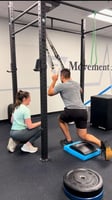Why ACL Injury Prevention Matters for Athletes ACL (anterior cruciate ligament) injuries are among...
Effective Strategies for Reducing ACL Tear Risk
Discover how targeted exercises and training can significantly lower your risk of ACL tears and keep you active and injury-free.
Anatomy and Function of the ACL
The Anterior Cruciate Ligament (ACL) is one of the major ligaments that help stabilize your knee joint. It connects your femur to your tibia and is crucial for maintaining stability and prevents your shin bone sliding forward during physical activities. The ACL is particularly important for movements that involve sudden stops, direction change and jumping.
ACL injuries commonly occur when the ligament is overstretched or torn during high-impact activities, due to improper landing techniques or from muscle imbalances.
Importance of Strength Training for ACL Injury Prevention
Strength training is a important component of ACL injury prevention. Strong and balanced muscles around the knee joint, particularly the quadriceps and hamstrings, provide better support and stabilization. Having balanced muscle strength in the thigh and glutes reduces the strain on the ACL during physical and rotational activities.
Incorporating strength training exercises such as weighted squats, lunges, leg presses and balance training can help build the necessary muscle support. As well as focusing on core strength is essential, as a strong core can improve overall body mechanics and stability helping reduce the risk of knee injuries.
Role of Proprioception in Reducing ACL Tear Risk
Proprioception refers to the body's ability to sense its position and movement in space. This allows your body to know how much force, movement and effort is needed for a specific task. Improving proprioception can significantly reduce the risk of ACL injuries by improving your body's ability to react quickly and correctly to sudden changes in movement.
Proprioceptive training includes exercises that challenge your balance and coordination, such as single-leg balance, probation training, balance board exercises, single leg hopping and agility drills. These exercises help train your body to respond more effectively to unexpected movements, reducing strain on the ACL and reducing likelihood of an ACL tear.
Integrating ACL Prevention Strategies into Your Routine
To effectively reduce your risk of an ACL tear, it is essential to integrate prevention strategies into your regular workout routine. Start by incorporating a warm-up that includes dynamic stretches and mobility exercises to prepare your muscles and joints for activity. As well as combination of strength, balance and plyometric training weekly.
Incorporate exercises that not only strengthen the muscles around the knee, adding hip, glute and core strengthening to improve the overall stability of the lower body.
Plyometric exercises like jump squats, box jumps and single leg hopping can improve your explosive power and landing mechanics, which are crucial for preventing ACL injuries. Ensuring that you land softly and with proper alignment can greatly reduce the strain on your knees.
Consistency is key. Regularly include strength training, proprioceptive drills, flexibility and plyometric exercises in your routine. Consider working with a trainer or physical therapist to ensure you are performing exercises correctly and addressing any specific weaknesses or imbalances that could increase your risk of injury.
Ready to take your athletic performance to the next level and prevent injuries before they happen? Schedule a consultation with Elevation Athletics PT&P in Fort Worth today and discover the benefits of preventive physical therapy.
Contact us now to start your journey towards optimal health and performance!
%20(1).png?width=500&height=128&name=Elevation%20Atletics%20(3)%20(1).png)

